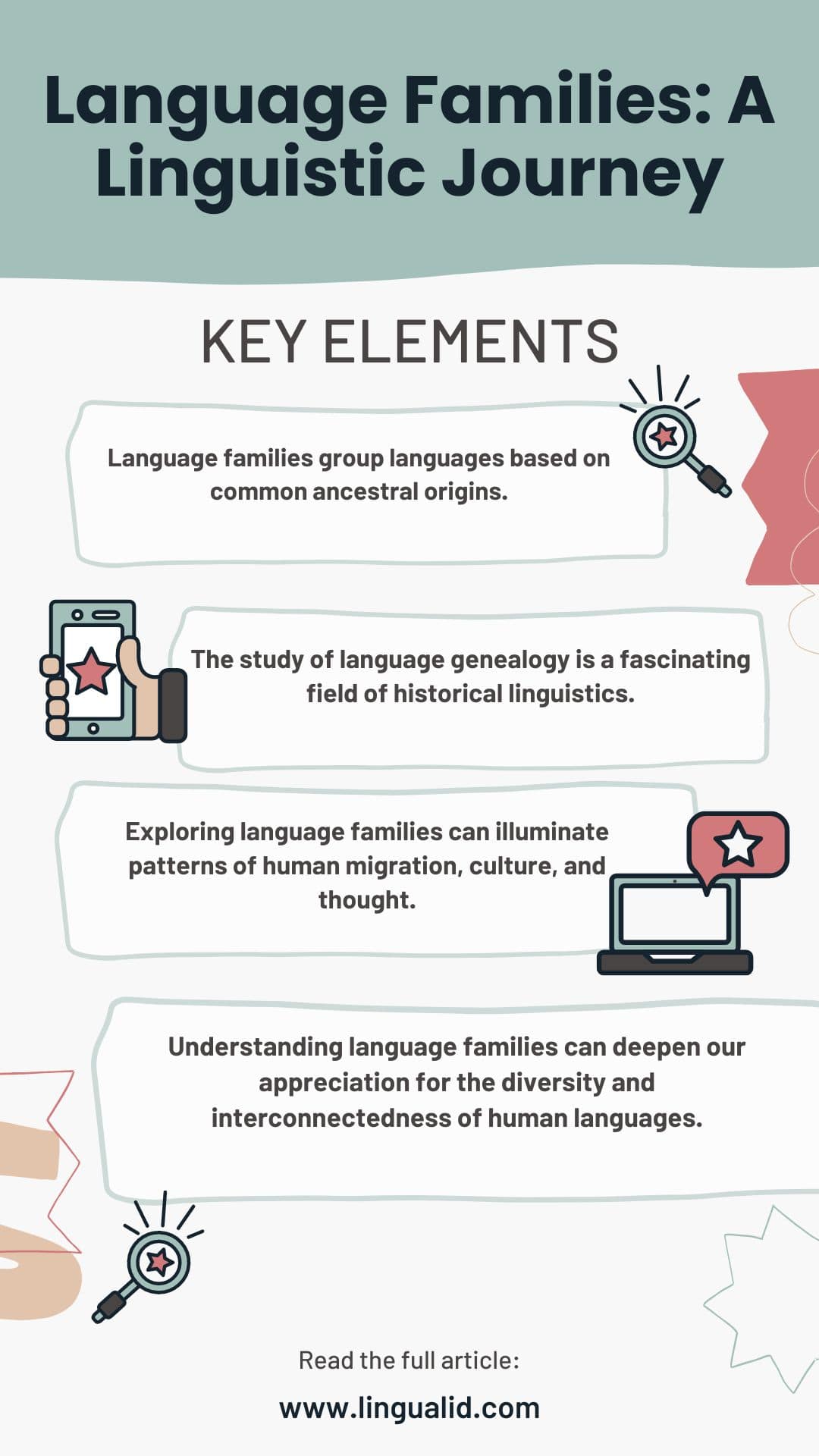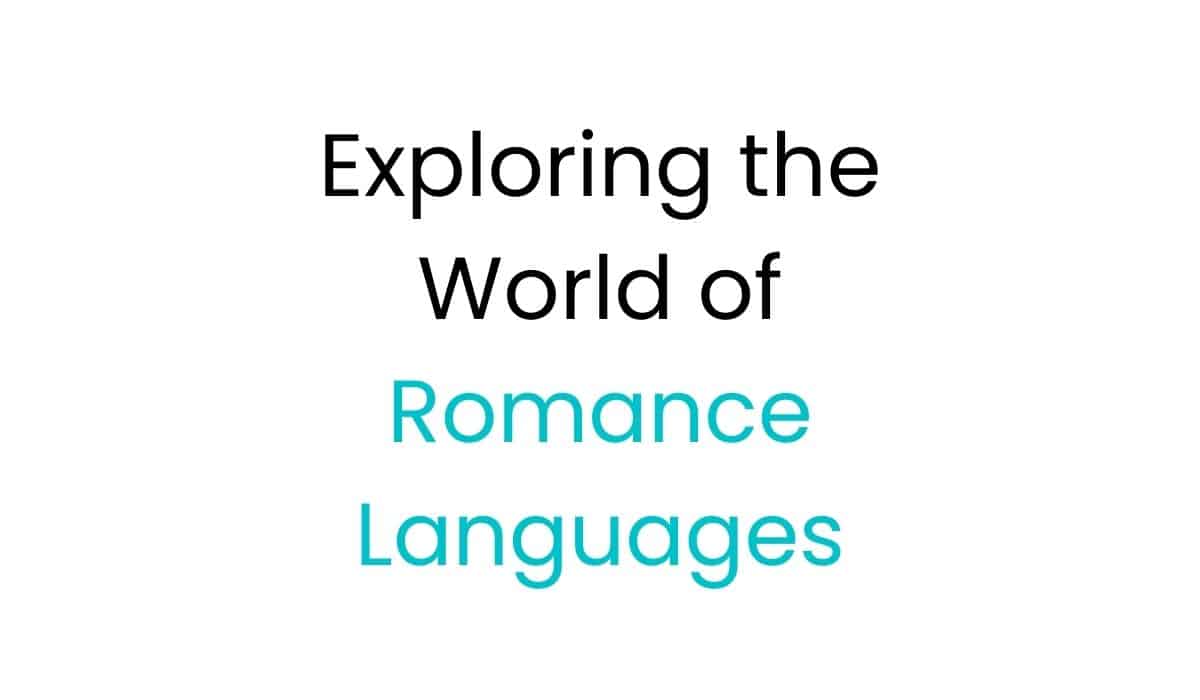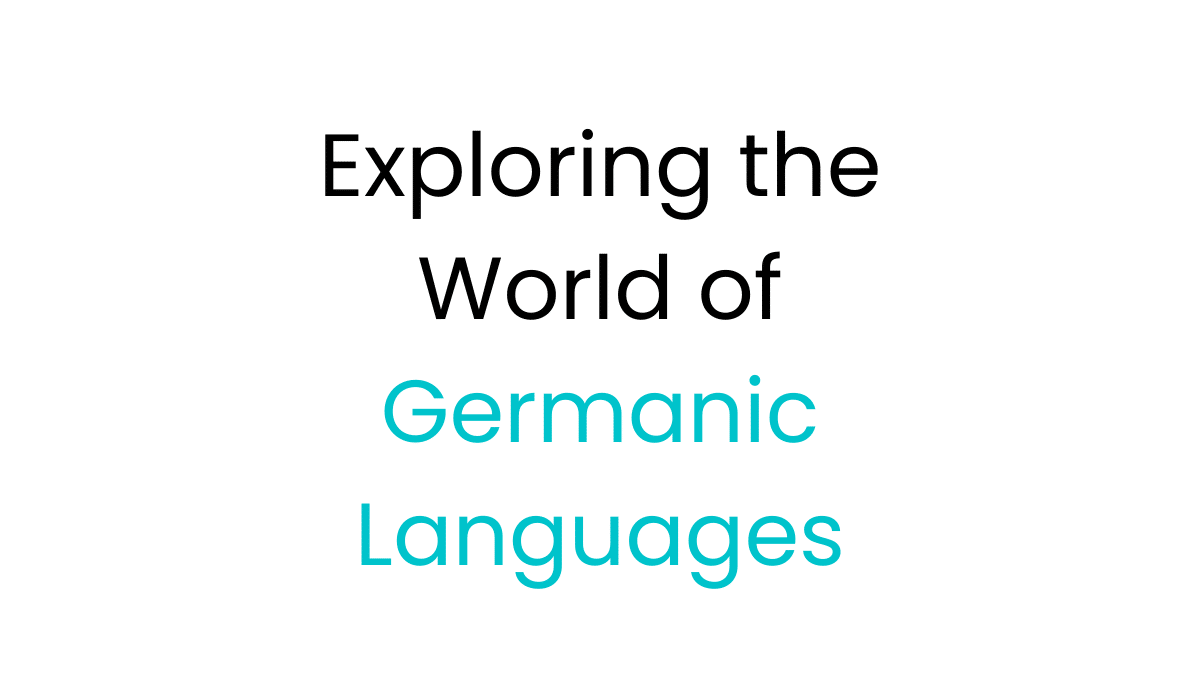Starting a journey to learn about language families is both exciting and informative. Language families connect languages that share a common ancestor. This journey shows us how people moved, their cultures, and their ways of thinking. It’s a way to see how languages have changed over time.
Looking into language genealogy, or the grouping of languages, is really interesting. By exploring these language lineages, we learn more about the variety and connections of human languages. We see how languages have influenced human history.
Key Takeaways
- Language families group languages based on common ancestral origins.
- Exploring language families can illuminate patterns of human migration, culture, and thought.
- The study of language genealogy is a fascinating field of historical linguistics.
- Understanding language families can deepen our appreciation for the diversity and interconnectedness of human languages.
- Seeking out the best resources can uncover the fascinating links between languages and their evolution.
- Key Takeaways
- Definition and Significance
- Major Language Families
- Geographical Scope
- Notable Examples
- Characteristic Features
- Regional Distribution and Prominence
- Linguistic Diversity and Branches
- Exploring the Branches of the Niger-Congo Family
- Island Influences and Unique Linguistic Traits
- Enhanced Language Learning
- Cultural Appreciation
- Start with a Familiar Language
- Utilize Cognates
- Online Linguistic Databases
- Academic Journals
- What are language families?
- What are the major language families?
- What are the characteristics of the Indo-European language family?
- What are the features of the Sino-Tibetan language family?
- How is the Afro-Asiatic language family distributed?
- What is the diversity of the Niger-Congo language family?
- What are the unique features of the Austronesian language family?
- How can understanding language families benefit language learning?
- How can language learners leverage their knowledge of language families?
- What resources are available to explore language families?
- How can cultural immersion enhance language learning within the context of language families?
Introducing Language Families
Language families are groups of languages that come from the same ancestor. They show the history, culture, and movements of people around the world. By looking at these connections, experts can see how languages have changed over time.
Definition and Significance
A language family is a group of languages that come from one original language. Knowing about language families helps us understand where languages come from and how they relate to each other. This knowledge gives us clues about human history, communication, and culture.
Major Language Families
There are several big language families in the world, each with its own special traits and where they are spoken. Some of the biggest ones are:
- Indo-European
- Sino-Tibetan
- Afro-Asiatic
- Niger-Congo
- Austronesian
These families differ in size, where they are spoken, and the number of languages they include. Knowing about these families helps us see how languages connect and have influenced human society.
Indo-European Family
The Indo-European language family is huge and widely spoken around the world. It covers a vast area, with languages in Europe and parts of Asia. These languages share a common ancestor, shown in their grammar and words.
Geographical Scope
About 46% of the world speaks Indo-European languages, which is around 3.2 billion people. There are about 445 living languages in this family. The Indo-Iranian branch has 313 of them.
Notable Examples
English, Spanish, Portuguese, Russian, and many others are part of this family. These languages have over 100 million native speakers each. This shows the big impact of the Indo-European languages.
Characteristic Features
- The Proto-Indo-European language was the first language of all Indo-European languages. It was spoken in the Neolithic or early Bronze Age.
- The Kurgan hypothesis says the Proto-Indo-European homeland was in Ukraine and southern Russia. This is widely accepted by scholars.
- Indo-European languages have a long history, second only to Afroasiatic languages like Egyptian and Semitic.
- The study of these languages greatly influenced historical linguistics in the 19th century.
The Indo-European language family is interesting for its wide reach, many speakers, and deep history. It’s a key area of study for linguists and those who love languages.
Sino-Tibetan Family
The Sino-Tibetan language family is huge and diverse. It’s found in East Asia, Southeast Asia, and the Himalayas. It has over 300 languages and major dialects, making it the second-largest family after Indo-European.
Chinese languages lead the Sino-Tibetan family with nearly 1.2 billion speakers worldwide. The Sinitic group, with Mandarin Chinese at the top, is the biggest branch. The family also includes Tibeto-Burman languages spoken in places like Tibet, Myanmar, and Nepal.
The Tibeto-Burman branch is very diverse. It includes languages like Tibetic and Burmish. Some think it might be linked to Tai and Karen languages, suggesting a “Sino-Austric” group.
There’s still debate among scholars about the family’s structure and relationships. They’re working to understand the proto-languages and subgroups of this vast family.
The Sino-Tibetan family is known for its tonal languages and logographic writing, especially in Chinese. This diversity shows the rich culture of the regions. It also offers many areas for further study and discovery.
Afro-Asiatic Family
The Afro-Asiatic language family includes over 400 languages. It covers the Middle East, North Africa, and the Horn of Africa. This family has the Semitic and Cushitic branches, with languages like Arabic, Hebrew, Amharic, and Somali. With about 500 million native speakers, these languages have deeply influenced the culture and religion of their areas.
Regional Distribution and Prominence
Afro-Asiatic languages are mainly found in the Middle East, North Africa, and the Horn of Africa. Arabic is the most spoken, with around 300 million native speakers. Other key languages are Hausa (Chadic) with 40 million speakers, Oromo (Cushitic) with 34 million, Amharic (Semitic) with 25 million, and Somali (Cushitic) with 17 million speakers.
Linguistic Diversity and Branches
- The Afro-Asiatic family has six main branches: Amazigh, Chadic, Cushitic, Egyptian, Omotic, and Semitic.
- These languages show a wide variety of features. Amazigh, Semitic, and Egyptian are non-tonal. Chadic, Cushitic, and Omotic use tones.
- Chadic has between 150 to 190 languages, the most in the Afro-Asiatic family.
The Afro-Asiatic language family is known for its rich heritage and wide use. It includes the Middle East, North Africa, and the Horn of Africa. Its diverse languages offer a glimpse into the culture and history of these areas.
| Afro-Asiatic Language | Native Speakers (Approximate) |
|---|---|
| Arabic | 300 million |
| Hausa | 40 million |
| Oromo | 34 million |
| Amharic | 25 million |
| Somali | 17 million |
| Berber Languages | 16 million |
Niger-Congo Family
The Niger-Congo language family shows the amazing variety of languages in Sub-Saharan Africa. It has over 1,400 different languages. About 85% of Africans, or more than 600 million people, speak a Niger-Congo language.
The Bantu languages are known for their complex noun classes and rich oral traditions. Languages like Swahili, Yoruba, Igbo, and Zulu are well-known worldwide. The Bantu expansion started around 1000 BC, leading to the blending and sometimes the loss of indigenous groups in Central and Southern Africa.
With so many Niger-Congo languages, the region’s linguistic richness is clear. From the Mande languages in the west to the Kordofanian languages in the east, the family’s diversity shows the area’s cultural and linguistic strength.
Exploring the Branches of the Niger-Congo Family
The Niger-Congo family has nine main branches, each with unique traits and features. These include:
- Mande
- Kordofanian
- Atlantic
- Ijoid
- Kru
- Gur
- Adamawa-Ubangi
- Kwa
- Benue-Congo, including the renowned Bantu languages
The Benue-Congo subfamily, which includes the Bantu languages, likely started at the Benue and Niger Rivers in central Nigeria. This spot is key to the region’s language and culture.
The Niger-Congo family’s vast language diversity and spread make it a captivating topic. It offers a peek into the rich world of Sub-Saharan African languages and cultures for linguists and enthusiasts.
Austronesian Family
The Austronesian language family covers a vast area, from the Pacific Islands to Southeast Asia and Madagascar. It includes about 1,200 languages, making up one-fifth of the world’s languages. Before European colonization, Austronesian languages spread widely, from Madagascar to Easter Island, across 206 degrees of longitude.
Island Influences and Unique Linguistic Traits
Austronesian languages are mainly spoken near the Equator but reach as far north as Taiwan and as far south as New Zealand. This wide range has led to a lot of diversity. The languages show unique traits shaped by island cultures.
For example, Malay and Tagalog have maritime vocabulary. The family’s languages also have complex sounds and structures. This makes the Austronesian languages very interesting to study.
| Notable Austronesian Languages | Number of Speakers |
|---|---|
| Javanese | 75.5 million |
| Malay | 17.6 million |
| Tagalog | 15.9 million |
| Cebuano | 20 million |
| Malagasy | 26 million |
Languages like Malay, Javanese, Tagalog, and Malagasy have over a million speakers each. The Austronesian family shows the rich linguistic diversity of the Pacific, Southeast Asia, and the Indian Ocean. These languages have greatly influenced the culture and language of their areas, from the Philippines to Madagascar.
Language Families
Language families show how languages are connected and have changed over time. They help us see patterns of migration and cultural exchange. These patterns have made the world’s languages as diverse as they are today.
The Indo-European Language Family is huge, with hundreds of languages. It includes Germanic, Romance, Baltic, and Slavic languages. The Romance Language Family shows how Latin turned into languages like Spanish, French, and Portuguese.
The Sino-Tibetan Language Family has over 400 languages in East Asia. The Afro-Asiatic Language Family is also big, with languages in North and East Africa and the Arabian Peninsula.
Other big families are the Dravidian Language Family in South Asia, the Austronesian Language Family in Africa, Eurasia, and Oceania, and the Uralic Language Family, which includes Hungarian, Finnish, and Estonian.
Looking into language families helps us understand how human communication has grown and changed. It shows us the cultural exchanges that have shaped languages around the world.
Benefits of Understanding Linguistic Connections
Learning about language families can really help with language learning. It makes it easier to pick up related languages because of shared words and grammar. Plus, it gives us a peek into cultures, history, and how people moved around, making us appreciate languages more.
Enhanced Language Learning
Looking into language families speeds up learning new languages. By spotting common roots and structures, learners can use what they know to quickly get the hang of related languages. This makes learning languages faster and more fun, helping people grow their language skills.
Cultural Appreciation
Exploring language families shows us the cool things about cultures, history, and how people interacted over time. It helps us see the beauty of human cultures and the world’s rich heritage. This makes us more understanding, respectful, and connected to others.
| Language Learning Benefits | Cultural Appreciation Insights |
|---|---|
| Faster language acquisition through recognition of shared vocabulary and structuresLeveraging existing linguistic knowledge to learn related languages more efficientlyEmpowering individuals to expand their linguistic repertoire | Unveiling cultural contexts and historical ties that have shaped language familiesFostering empathy, respect, and a deeper understanding of global cultural diversityEnhancing appreciation for the rich tapestry of human heritage and migration patterns |
By looking into language families, we open up a world of discovery. It makes learning languages and understanding cultures better, enriching our lives.
Practical Applications for Language Learners
Language learners can use their knowledge of language families to improve their skills. Starting with a language you know well within the same family helps build on what you already know. Also, learning words that are similar in form and meaning across languages can quickly grow your vocabulary and understanding.
Start with a Familiar Language
Starting a new language journey can be easier if you pick one from the same family as a language you know. This method uses the similarities in grammar, vocabulary, and pronunciation you’re already familiar with. For example, if English is your first language, learning another Indo-European language like Spanish or French can be a smooth transition. You can use your knowledge of similar words and sentence structures.
Utilize Cognates
Cognates are words that look and mean the same in different languages. Using cognates can speed up learning new words and understanding. For instance, the English word “family” is the same as the Spanish word “familia.” This makes it easier for English speakers to remember the Spanish word. Focusing on cognates is a great way to learn languages within the same family.
Learning about language families and cognates can really change the game for language learners. By using these connections, you can make learning faster, grow your vocabulary, and get a deeper understanding of the language.
Exploring Language Families Through Resources
Exploring language families is exciting and requires good resources. Luckily, there are many tools available. These include online databases and academic journals.
Online Linguistic Databases
Online databases are full of info on language families. They have detailed classifications and interactive maps. This lets users see how languages are connected and differ.
These resources help us understand how languages change and group together.
Academic Journals
Academic journals are key for language family research. They share new studies and discussions. These articles cover the history, culture, and structure of languages.
They keep readers up-to-date with the latest in language studies.
Using online databases and journals helps us learn about language families. These tools let us see the complex relationships and changes in languages. They make exploring languages a fascinating journey.
| Resource Type | Examples | Key Features |
|---|---|---|
| Online Linguistic Databases | Ethnologue Glottolog World Atlas of Language Structures (WALS) | Comprehensive language family classificationsInteractive language mapsDetailed phonological and grammatical data |
| Academic Journals | Language Linguistic Typology Journal of Language Evolution | Peer-reviewed research and analyses on language familiesDiscussions on language evolution and classificationInsights from leading experts in the field of linguistics |
Immersive Experiences and Cultural Contexts
Diving into the cultures tied to the languages you’re learning can really boost your language skills. By connecting with native speakers, diving into local customs, and checking out music, literature, and films, you can grow a deeper appreciation for language nuances and their role in culture.
Immersion learning puts you right into real-life situations. This means you get to hear how words are really used, pick up on idioms, and understand cultural details that textbooks might miss. It helps you learn by doing, not just reading, making it easier to speak naturally.
Being immersed lets you try out new words and phrases without fear of making mistakes. It’s a safe place to learn and improve fast. Plus, it makes you want to keep learning by using the language in everyday life, which is key to language learning.
Getting to know a culture through immersion helps you understand its values and beliefs better. These immersive experiences can break down wrong ideas and help you see people from other cultures as individuals. This leads to real connections and friendships across different cultures.
| Immersion Program Type | Key Characteristics |
|---|---|
| Full Immersion | Complete submersion into the language and culture, maximizing exposure and practice. |
| Partial Immersion | Learners split their time between using the target language and their native language, providing initial support for beginners. |
| Cultural Exchange | Offers a holistic understanding of language within its cultural context through living with host families or community activities. |
| Language Camps and Workshops | Provide short-term, condensed periods of intensive language exposure for rapid skill development. |
Research shows that students who dive deep into a language do better in speaking it. Immersive language experiences are especially good for kids. This is because learning a language early on can really set them up for success.
“Immersion in a new language leads to enhanced motivation through practical communication in everyday situations, driving effective language acquisition.”
Even digital tools like watching videos, joining webinars, and playing games can help you get to know a language and its cultural context. Using the language in real-life settings online can make your learning stronger and more meaningful.

Conclusion
Exploring the world’s language families shows us the beauty of human communication. It helps us see how languages have evolved and spread. By looking into their origins and unique traits, we learn a lot that makes language learning more interesting.
There are over 7,000 living languages, each with its own story and culture. The Indo-European family includes English, while the Sino-Tibetan and Afro-Asiatic families are also vast. These languages show how creative and adaptable humans are. Learning about these families makes language easier and helps us find connections across cultures.
Studying language families is more than just schoolwork. It opens our eyes to the world and its people. By seeing how languages connect and differ, we value human expression more. This helps us share cultures and build a global community that welcomes everyone.
FAQ
What are language families?
Language families are groups of languages that come from the same ancestor. They show how people moved and mixed cultures over time.
What are the major language families?
The big ones are Indo-European, Sino-Tibetan, Afro-Asiatic, Niger-Congo, and Austronesian.
What are the characteristics of the Indo-European language family?
Indo-European is huge, covering languages in Europe and Asia. It includes English, Spanish, Hindi, and many others. These languages share grammar and words, showing they come from the same roots.
What are the features of the Sino-Tibetan language family?
Sino-Tibetan languages are mainly in East Asia and the Himalayas. They include Mandarin, Tibetan, and Burmese. They’re known for their tones and logograms, especially in Chinese.
How is the Afro-Asiatic language family distributed?
Afro-Asiatic is big in the Middle East, North Africa, and East Africa. It has Semitic and Cushitic branches, with languages like Arabic and Amharic. It’s famous for ancient texts and religious books.
What is the diversity of the Niger-Congo language family?
Niger-Congo covers much of Sub-Saharan Africa. It has many languages, like Swahili and Yoruba. The Bantu languages are known for their complex grammar and stories.
What are the unique features of the Austronesian language family?
Austronesian spans the Pacific, Southeast Asia, and Madagascar. It includes Malay and Hawaiian. It’s known for its sea-related words and diverse dialects.
How can understanding language families benefit language learning?
Knowing about language families helps us see how languages evolved and changed. It makes learning easier because of shared words and grammar. It also helps us appreciate cultures and languages more.
How can language learners leverage their knowledge of language families?
Start with a language you know, then move to related ones. Using cognates can also boost your vocabulary and understanding.
What resources are available to explore language families?
There are many online databases with info on language families. Academic journals also offer the latest research on these topics.
How can cultural immersion enhance language learning within the context of language families?
Immersing yourself in the culture of the language helps a lot. It means talking with native speakers, enjoying local customs, and checking out music and books. This way, you get to know the language better and its role in culture.
Oualid Cheddadi is the founder of Lingualid, a platform that inspires independent language learners worldwide, regardless of the language they are learning. The name “Lingualid” is derived from the Portuguese word for “language,” “língua,” and the last three letters of Oualid’s name, “Lid.”



